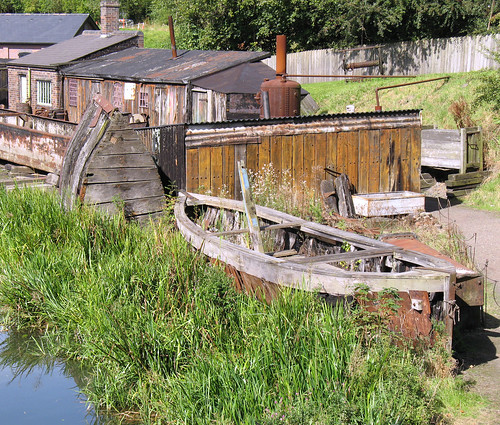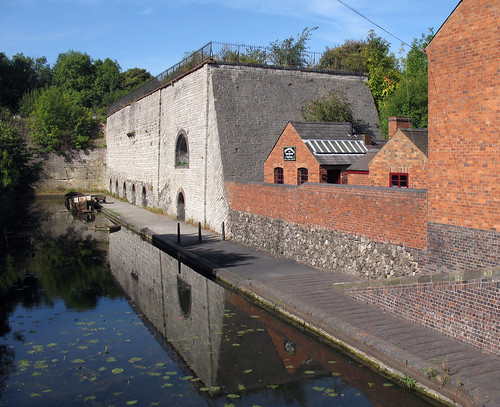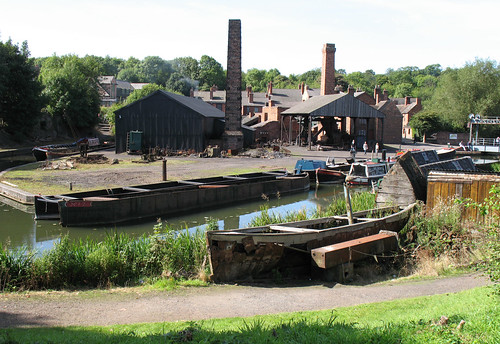 The Black Country Museum gives a great insight into the social history of the Black Country. Old buildings have been moved and authentically rebuilt within the museum to recreate a village that is centred round a canal. The museum is a living history of the traditional skills of the area where skilled craftsmen and costumed demonstrators bring history alive.
The Black Country Museum gives a great insight into the social history of the Black Country. Old buildings have been moved and authentically rebuilt within the museum to recreate a village that is centred round a canal. The museum is a living history of the traditional skills of the area where skilled craftsmen and costumed demonstrators bring history alive.
The area around the canal was quite photogenic and I couldn’t resist taking some photographs of it, when I was at the museum on Saturday. The picture below depicts a set of limekilns that were originally built in 1842. The small building with the sign over the top is a glass cutters workshop.
Quarried extensively in Sedgley, Dudley and Walsall, limestone was one of the great wealth of raw materials that contributed to the successful industrial development of the Black Country. It was used in iron making as a flux in the furnaces but could also be converted to lime by burning.
‘Quicklime’ was used to make mortar and plaster for the building trade, in agriculture as a fertiliser and as ’slaked’ lime for making whitewash.
The large set of kilns overlooking the village were built in 1842 and were in use until about 1926, burning limestone excavated from nearby Castle Hill and Wren’s Nest. Twenty-eight feet high chimneys topped the shafts of the kilns and belched out smoke and fumes continuously.
The lime works and canal basin were once at the hub of industrial activity within the Black Country.
The canal arm was built from the main Wolverhampton-Birmingham line especially to serve these kilns.
Earlier ‘horseshoe’ and ’shaft’ kilns were built near the entrance to Dudley Canal Tunnel.
The underground canals were built in the late eighteenth century to carry stone from the mines and were linked into the Midlands canal network.
The two most prominent buildings in the following picture are the rolling mill to the left of the picture.
The rolling mill depicts a typical Black Country hand rolling mill in which iron and later, steel bars were reduced in size or changed in section.
The iron bars are heated up in the cast iron furnace and then passed through the mill stands several times to reduce the size of the section.
It was installed at Birchley Rolling Mills, Oldbury in 1923 using second hand parts and has been reconstructed at the Museum as it would have appeared around 1900.
When in operation the mill is now driven by a modern electrical motor.
And the anchor forge to the right of the picture.
The open-sided shed standing in the middle of the ironworks is the anchor forge which was rescued from Isiah Preston’s in Cradley Heath.
The steam-hammer was installed second hand in the 1920s to forge parts for ships’ anchors and the other equipment including furnace and boiler also came from Prestons.
The building was saved from Johnson’s Rolling Mill site in West Bromwich.
The iron billets are heated in the furnace and suspended from a crane in order that they can be manipulated beneath the steam powered hammer.
The heat from the furnace also raises steam in the boiler between the furnace and the chimney and this steam powers the hammer which reduces the size of the iron and forges it into the shape required.










That definitely looks like it’s worth a visit
I am sure you would enjoy it. I intend to go back and explore it more fully on a quieter day
Got stuck on the rolling mill link for a while – a fascinating place to visit.
There are some really fascinating buildings there, I intend to go back
I have visited here with a group of school children, they enjoyed it!
I can imagine they did, it is an ideal place for children – education in a fun way
I feel guilty about not making a visit….but I can remember the real area in the 40’s/50’s. The organ club I belong to, hold
‘gatherings’ there. I must book myself/organ in for the next one.
(We get in free as well!..)
You really should go, it is a very interesting place. It was my first visit and I will be going back. It has also inspired me to go back to the Blists Hill museum nr Ironbridge.
You do get to some interesting places, cherrypie.
I like to get out and about and see interesting things
Did you have a go in that canoe?
If you meant the one in the top pic… No way, I like to keep dry
Thank you for the tour, Cherie. I never made it to the museum, and wish I had – but your post is the next best thing! Industrial archaeology has worked wonders, hasn’t it?
I find industrial archeology quite fascinating. In fact I could just say I find history interesting
I would love to visit this part of the country sometime.
I hope you get a chance to, there are lots of interesting things to see
Cherie
Just been reading some of the comments on your site, and couldn’t resist adding one of my own. I actually work at the BCLM as a volunteer, and I am based at the Racecourse Colliery, right opposite the mine entrance. I run the weighbridge, which has now been in full action for the first time since we decided to re-open it for visitors to the museum. Period costume still applies, but don’t expect us to talk about modern day things. We don’t acknowledge them, as we talk in black country accent, and are stuck in a time warp from the years 1880-1930. Bring your kids, neices, nephews…whoever. Get a gift pack of real Black Country Coal samples, lollies, and a certificate of being a genuine victorian! Our educative talks are both funny and interesting. It’s a new experience, which I’m sure would be an added bonus since your last visit. Drop in…we’d love to meet you!
Thanks for your interesting comment
That sounds like a really fun thing to volunteer for. I am intending on coming back hopefully in the summer and I hope to make the special chain makers festival this year. So maybe I will see you there